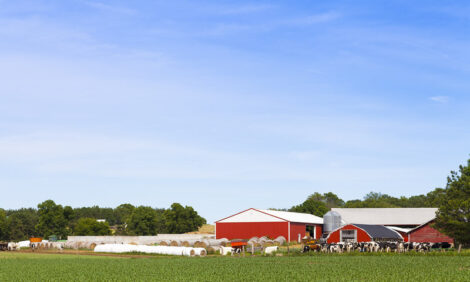



Reducing Lameness in Dairy Cows
Lameness in dairy cows is one of the issues being tackled by Welfare Quality®, an EU-funded research project designed to integrate farm animal welfare into the food chain by developing reliable on-farm welfare assessment systems and practical strategies to improve farm animal welfare.According to researchers participating in Welfare Quality®, farmers significantly underestimate the amount of lameness in their herds and in doing so, not only risk reducing the welfare of their animals but also losing some of their profits at the same time. Though farmers estimate about 5% to 10% of their dairy cows suffer from lameness, the average is closer to 25% of the herd. Lameness reduces the efficiency of a cow’s milk production, with an estimated average loss of €200 per cow, per year. In other words, this welfare problem accounts for a loss of 5% to 10% of a farmer’s annual income per cow.
However, thanks to research done in Welfare Quality®, some practical support has been developed that will help farmers shrink their financial losses while improving the quality of life for their cows.

A few practical tips…
When aiming to reduce lameness in the dairy herd, one of the first places to look is the housing system. Even in the narrow range of around one cubicle per cow, i.e. on average 0.85 to 1.15 cubicles per cow, the more cubicles there are available to a cow, the better off she will be. But not just any cubicle will do. The size of the cow in relation to the size of the cubicle is vital as are the softness and cleanliness of the lying area. If the cubicle isn’t up to standard, this will increase the time that it takes a cow to lie down, which is a sign the stall isn’t comfortable for her.
Just as important as the cubicle is the cow’s diet. As a ruminant, the amount of forage she consumes is vital to the workings of the gut, yet at the same time she requires a lot of energy to produce the amount of milk required of her. A balance must be struck so that she gets enough energy but is also given enough forage to counteract the amount of acid that can build up in her rumen and cause lameness issues. According to research done by Welfare Quality® on herds that were fed on average 0 kg up to 0.44 kg concentrates per kg milk, the risk of lameness increases with increasing amounts of concentrates fed. However, simply reducing the amount of concentrates compromises the energy status in high producing cows so the challenge is in balancing forage and energy.
The most obvious place to look in terms of lameness is at the health of the hoof itself. Though diet can have effects on the hoof and hoof wall, it is important to keep the area where she walks and milks dry and clean from slurry. Welfare Quality® researchers looked into the best type of flooring and the answer isn’t as simple as farmers might wish: cement floors, especially when slatted, new and abrasive, can damage the hoof and weaken the soles, causing lesions and eventually infections and abscesses. Also, such floors become slippery due to wear, yet alternative rubber floors are difficult to clean with standard manure scrapers and, especially when solid, can be slippery despite the soft surface. Finding a combination of favourable features of the two types of floor that works best in each particular situation may be a process of trial and error.

Getting a handle on monitoring
To reduce lameness in the dairy herd, it’s vital for farmers to develop a monitoring and control strategy that will look at the basic steps:
- Diagnosis – what is the problem and how big is it?;
- Risk assessment – what is causing the problem?;
- Control strategies – what can be done about it?;
- And Monitoring – is progress being made?
Welfare Quality® is developing a DVD and web-based monitoring programme to assist dairy farmers in all of these steps. The programme includes worksheets that can be tailored to suit individual farms. It will be made available in English for free, welfarequality.net and we expect to advertise this service in autumn 2008 on the Welfare Quality® website www.welfarequality.net.
Animal welfare can be a difficult concept to pin down, and many people have their own personal views. Despite this, there is general agreement within the scientific community that animals should be housed in comfortable surroundings and maintained in good health, as described in the Welfare Quality® fact sheet ‘Principles and criteria of good animal welfare’ (available on the website www.welfarequality.net).
The research on lameness done in Welfare Quality® has added scientific knowledge about root causes. Existing and new information has been applied in a webbased monitoring programme, which assists dairy farmers in addressing risk factors in a way that is tailored to their specific situation. Welfare Quality® is providing a means to effectively combat lameness in dairy cows and contribute to an economically efficient and animalfriendly dairy industry.
Footnote
This research was executed within the third Subproject of Welfare Quality®, which focuses on the development of practical strategies to improve farm animal welfare.
Welfare Quality® is a European research project focusing on the integration of animal welfare in the food quality chain. The project aims to accommodate societal concerns and market demands, to develop reliable on-farm monitoring systems, product information systems, and practical species-specific strategies to improve farm animal welfare. Forty-four institutes and universities, representing thirteen European countries and four Latin American countries, participate in this integrated research project.
Welfare Quality® is co-financed by the European Commission, within the 6th Framework Programme, contract no. FOOD-CT-2004-5065087.
The text represents the authors’ views and does not necessarily represent a position of the Commission, who will not be liable for the use made of such information.
May 2008



